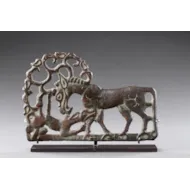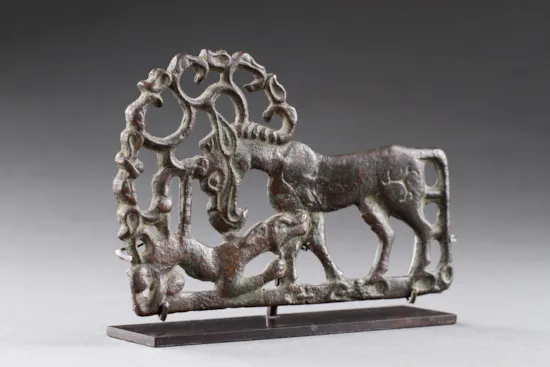A Rare Bronze Belt Ornament
A Rare Bronze Belt Ornament
Depicting a horse being attacked by a tiger
Rich dark brown glossy patina
Bronze
China / Ordos Region, Mongolia
Circa 300 BC
Size: 7.5cm high, 11cm wide - 3 ins high, 4¼ ins wide
Depicting a horse being attacked by a tiger
Rich dark brown glossy patina
Bronze
China / Ordos Region, Mongolia
Circa 300 BC
Size: 7.5cm high, 11cm wide - 3 ins high, 4¼ ins wide
A Rare Bronze Belt Ornament
Depicting a horse being attacked by a tiger
Rich dark brown glossy patina
Bronze
China / Ordos Region, Mongolia
Circa 300 BC
Size: 7.5cm high, 11cm wide - 3 ins high, 4¼ ins wide
Depicting a horse being attacked by a tiger
Rich dark brown glossy patina
Bronze
China / Ordos Region, Mongolia
Circa 300 BC
Size: 7.5cm high, 11cm wide - 3 ins high, 4¼ ins wide
To the north and along the western perimeter of the main Chinese settlements of the pre-Han and Han dynasty (3rd to 1st centuries BC) lived a nomadic peoples whose cultures were different from those of their Chinese neighbours. Numerous belt plaques, horse-gear and weapons depicting animals, often in combat, were produced in the region and throughout the period.
During the Han dynasty (206 BC-220 AD) the Chinese made treaties with the Xiongnu peoples who dominated the Mongolian and Ordos area at the time. Many of the surviving animal bronzes were made by the Xiongnu. Their tombs at Noin Ula, Mongolia, were found to contain many Chinese items, such as silk and bronze mirrors, besides their own bronze plaques and ornaments.
During the Han dynasty (206 BC-220 AD) the Chinese made treaties with the Xiongnu peoples who dominated the Mongolian and Ordos area at the time. Many of the surviving animal bronzes were made by the Xiongnu. Their tombs at Noin Ula, Mongolia, were found to contain many Chinese items, such as silk and bronze mirrors, besides their own bronze plaques and ornaments.
Ex Rupert Wace Ltd, Grosvenor House Antiques Fair, 2002
Ex Private collection
A Rare Bronze Belt Ornament






